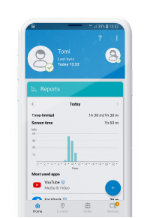While the internet offers countless opportunities for learning and growth, it also poses some risk – including the possibility that cybercriminals may steal your children’s personal information. Get to know the red flags.
Identity theft can affect children as well as adults. What makes data theft tricky is that it can often go undetected – and, as a result, the steps that lead to a solution may be long delayed. What can you do to prevent this? Stay vigilant and look out for these red flags:
- Unexplained financial activity: One of the most obvious signs of identity theft is unexplained financial activity in your child’s name. This could include receiving bills or statements for accounts you didn’t open or noticing unauthorized charges on your credit card or bank statements.
- Unexpected collection calls: Another bright red flag is receiving calls from debt collectors asking for payments on accounts you’re not familiar with. This could signal that someone has used your child’s identity to incur debts.
- Social Security number misuse: If your child’s Social Security number is being used fraudulently, you may receive notices from government agencies, credit bureaus, or other institutions, indicating unusual activity linked to your child’s information.
- Unexplained social media account activity: If you notice unusual login activity or changes to account settings that your child didn’t make, it could be a sign that their account has been compromised. It’s important to keep an eye on your child’s online accounts, including social media, gaming, and email.
- Unexpected password changes: If your child suddenly finds themselves locked out of their accounts due to password changes that they didn't initiate, it may indicate that someone else has gained unauthorized access to their accounts.
While it's crucial to know the signs of identity theft, it’s just as important to take precautions before anything happens and focus on prevention as the key aspect of digital security. Blithely waiting for something suspicious to pop up can put your child at risk. By being proactive and putting in place safety measures, you can lower the chance of data theft. So, what can you do to keep your child’s identity safer?
- Educate, educate, educate: Teach your children the importance of safeguarding their personal information online and encourage them to be cautious when sharing sensitive details or opening emails and messages from unknown senders. Make education fun with interactive material such as our HEY PUG! Workbook.
- Count on open communication: When your children feel comfortable talking to you about virtually anything, they’re more likely to share any mistakes they may have made (as we all sometimes do) and to bring up whatever suspicious activity they may have encountered online. You may then be able to take immediate, preventive steps such as changing passwords on their accounts, and protect their data.
- Use privacy settings: To limit the amount of personal information visible to strangers, make sure your child’s social media accounts and other online profiles are set to private.
- Monitor your child’s online activity: Thanks to ESET Parental Control, you can protect children not only from inappropriate online content but also from downloading sketchy apps that may turn out to be malware designed to collect their data.
- Secure devices and accounts: Install reputable security software on all devices you and your child use and enable multi-factor authentication whenever possible to add an extra layer of protection to your accounts. ESET HOME Security allows you to secure your browser, private files, and social media accounts, and the Ultimate version even has a dedicated Identity Theft feature, which…
Þ … scans thousands of websites, including those on the Dark Web, black market chat rooms, blogs, and other data sources to detect the illegal trading and selling of your personal information.
Þ … monitors your Facebook, Twitter, YouTube, and Instagram accounts for inappropriate activity and posts that could be perceived as violent.
Þ … can be used to protect 2 adults and up to 10 children under the age of 18 – so, in other words, the entire household.
- Stay informed and positive: Keep yourself in the loop about oncoming cybersecurity trends and threats that can affect children. Find trustworthy sources to stay updated – such as Safer Kids Online. But most importantly, don’t let all the information about various threats get you down! While it’s good to be aware of the potential risks, it’s better to stay positive and focus on all the amazing opportunities the internet offers our kids. By empowering your children with the right knowledge and tools, you can help them thrive in a secure online space where they can learn, explore and connect.


